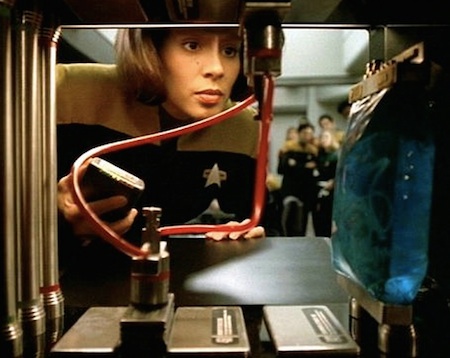Science Fiction
Dictionary
A B C D E F G H I J K L M N O P Q R S T U V W X Y Z
Living Slime Mold Builds Logical Circuits

European researchers have built circuit logic units using living slime molds; this could be the start of computing devices and sensors. Andrew Adamatzky (University of the West of England, Bristol, UK) and Theresa Schubert (Bauhaus-University Weimar, Germany) have used networks of living, interconnected slime mold tubes to process information.
Using the dyes with magnetic nanoparticles and tiny fluorescent beads, allowed them to use the slime mold network as a biological "lab-on-a-chip" device. This represents a new way to build microfluidic devices for processing environmental or medical samples on the very small scale for testing and diagnostics, the work suggests. The extension to a much larger network of slime mold tubes could process nanoparticles and carry out sophisticated Boolean logic operations of the kind used by computer circuitry.
The team has so far demonstrated that a slime mold network can carry out XOR or NOR Boolean operations. Chaining together arrays of such logic gates might allow a slime mold computer to carry out binary operations for computation.
"The slime mold based gates are non-electronic, simple and inexpensive, and several gates can be realized simultaneously at the sites where protoplasmic tubes merge," conclude Adamatzky and Schubert.
Fans of Star Trek Voyager may recall similar technology described in the 1995 episode Caretaker.
In earlier work, the team demonstrated that such a tube network could absorb and transport different colored dyes. They then fed it edible nutrients -- oat flakes -- to attract tube growth and common salt to repel them, so that they could grow a network with a particular structure. They then demonstrated how this system could mix two dyes to make a third color as an "output."

(Blue gel pack in the panel behind a replicator )
The gel packs formed the basis of the bio-neural circuitry, which was essentially an organic computer system. The packs contained neural fibers surrounded in a blue gel with metallic interfaces on the top and bottom. They helped store more information and operated at faster speeds than isolinear circuitry.The fibers in an individual gel pack were capable of making billions of connections, thus generating an incredibly sophisticated and responsive computing architecture. This kind of organic circuitry allowed computers to "think" in very similar ways to living organisms; by using "fuzzy logic", they could effectively operate by making a "best guess" answer to complex questions rather than working through all possible calculations. This was due in part to the inherent ability of organic neural systems to correlate chaotic patterns that eluded the capacities of conventional hardware.
Via ScienceDaily; thanks to an anonymous reader for the tip and reference on this story.
Scroll down for more stories in the same category. (Story submitted 3/28/2014)
Follow this kind of news @Technovelgy.| Email | RSS | Blog It | Stumble | del.icio.us | Digg | Reddit |
Would
you like to contribute a story tip?
It's easy:
Get the URL of the story, and the related sf author, and add
it here.
Comment/Join discussion ( 0 )
Related News Stories - (" Computer ")
Is Agentic AI The Wrong Kind Of Smartness?
'It’s smart enough to go wrong in very complicated ways, but not smart enough to help us find out what’s wrong.' - Isaac Asimov, 1975.
Jetson Orin Nano Super 70 Just $249
'Rayno folded up the microterm and tucked it back inside his jumper.' - Bruce Bethke, 1983.
Automatic Bot Traffic Is 38 Percent Of HTTP Requests
'there were so many worms and counterworms loose in the data-net...' - John Brunner, 1975
Neuroplatform Human Brain Organoid Bioprocessor Uses Less Electricity
'Cultured brains on a slab.'- Peter Watts, 1999
Technovelgy (that's tech-novel-gee!) is devoted to the creative science inventions and ideas of sf authors. Look for the Invention Category that interests you, the Glossary, the Invention Timeline, or see what's New.
Science Fiction
Timeline
1600-1899
1900-1939
1940's 1950's
1960's 1970's
1980's 1990's
2000's 2010's
Current News
Sunday Robotics 'Memo
'He then started hand movements of definite pattern...'
Woman Marries Computer, Vonnegut's Dream Comes True
'Men are made of protoplasm... Lasts forever.'
Natural Gait With Prosthetic Connected To Nervous System
'The leg was to function, in a way, as a servo-mechanism operated by Larry’s brain...'
Spidery 'Walk Me' Toyota Autonomous Wheel Chair Like Star Wars
Walk along with the emperor.
Dancing Robots Taught Dance Moves
'A clockwork figure would be the thing for you...'
Proof Of Robothood - Not A Person
'Who are you people? - Show 'em.'
Indonesian Clans Battle
'The observation vehicle was of that peculiar variety used in conveying a large number of people across rough terrain.'
The 'Last Mile' In China Crowded With Delivery Robots
Yes, it's a delivery robot. On wheels.
Tornyol Microdrone Kills Mosquitoes
'The real border was defended by... a swarm of quasi-independent aerostats.'
PLATO Spacecraft, Hunter Of Habitable Planets, Now Ready
'I ... set my automatic astronomical instruments to searching for a habitable planet.'
Factory Humanoid Robots Built By Humanoid Robots
'...haven't you a section of the factory where only robot labor is employed?'
iPhone Air Fulfils Jobs' Promise From 2007 - A Giant Screen!
'... oblongs were all over the floor and surfaces.'
ChatGPT Now Participates in Group Chats
'...the city was their laboratory in human psychology.'
iPhone Pocket All Sold Out!
'A long, strong, slender net...'
Did The Yautja Have These First?
What a marvel of ingenuity the little device was!
Jetson ONE Air Races Begin, Can Air Polo Be Far Behind?
'If you're one of those rarities who haven't attended a rocket-polo "carnage", let me tell you it's a colorful affair.'
